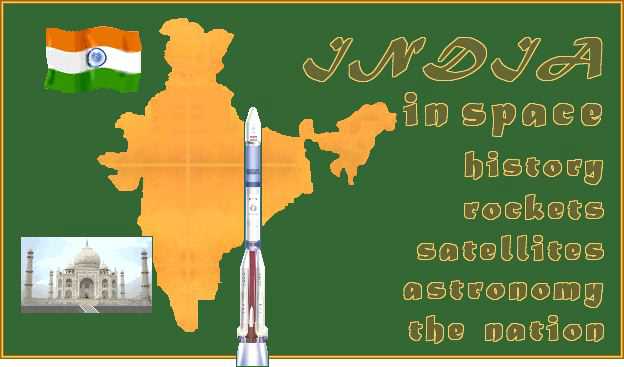

India's Space Rockets
India launches a powerful GSLV rocket toward space
India launched its first sub-orbital sounding rocket on Nov. 21, 1963.
SLV. The first experimental launch of a Satellite Launch Vehicle (SLV) rocket took place on August 10, 1979.
Eleven months later, on July 18, 1980, India launched its first satellite, Rohini-1, to orbit on an SLV from the Sriharikota Island launch site.
Since then, India has invested a great deal of development work in more powerful rockets.
ASLV. The first developmental launch of a larger Augmented Satellite Launch Vehicle (ASLV) rocket took place on March 24, 1987. Although an ASLV could lift a 300-lb. satellite to an orbit 250 miles above Earth, it was unsuccessful in its first try. The second developmental launch of an ASLV in July 1988 also failed. Later, the third and fourth attempts were successful.
PSLV. The even larger Polar Satellite Launch Vehicle (PSLV) debuted in September 1993, but failed to attain orbit. Its individual elements were successful. PSLV could lift a one-ton satellite to a Sun-synchronous polar orbit.
GSLV. The first attempt to launch a still larger Geosynchronous Satellite Launch Vehicle (GSLV) rocket on March 28, 2001, failed on the pad when four strap-on boosters failed to reach the required thrust.
Shar Space Launch Center on Sriharikota Island off India's east coast state of Andhra Pradesh is used by ISRO to launch space rockets.
A GSLV was launched on April 18, 2001, from the Sriharikota Island launch site in the southern state of Andhra Pradesh. It successfully placed a 1.5-ton experimental satellite called GSAT-1 into geosynchronous orbit 22,300 miles above Earth.
A GSLV has three rocket stages, is 161 feet tall, and could boost a 2.5-ton satellite, such as large communications and weather satellites, to high stationary orbits. India also plans to use GSLV rockets to send probes away from Earth to explore the planets. Missions to Mercury, Venus and Mars are under consideration.
With a Russian engine. For the first GSLV flight in 2001, India purchased a Russian RD56M upper stage rocket engine and mounted it as the upper stage of the GSLV. The RD56M had been developed by Russia for its Proton-M rocket. A Russian RD56M upper stage also was to be used on the second GSLV flight in Summer 2002.
After that, five RD56Ms would remain for India's use as the South Asia nation had purchased seven RD56Ms from the Russians.
Without a Russian engine. Indian Space Research Organization (ISRO) is developing its own cryogenic upper stage and plans to equip a GSLV with it for a launch of a 4,400-lb. satellite in 2003.
An even more powerful engine could be available for flight testing in 2004 or 2005. A powerful upgraded version III of the GSLV could be ready to fly in 2007.
Commercial launches. India hopes to tap into the commercial launcher market. The first commercial GSLV launch is set for 2002-03, to be followed by two launches per year through 2006-07.